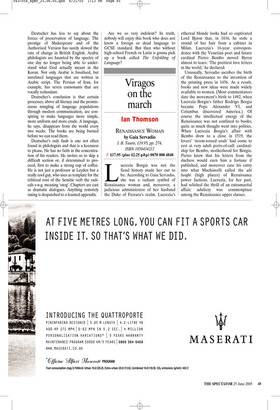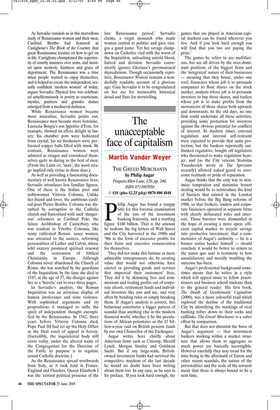Viragos on the march
Ian Thomson
RENAISSANCE WOMAN by Gaia Servadio I. B. Tauris, £19.95, pp. 274, ISBN 1850434212 ✆ £17.95 (plus £2.25 p&p) 0870 800 4848 Lucrezia Borgia was not the fiend history made her out to be. According to Gaia Servadio, she was a radiant symbol of Renaissance woman and, moreover, a judicious administrator of her husband the Duke of Ferrara’s realm. Lucrezia’s ethereal blonde looks had so captivated Lord Byron that, in 1816, he stole a strand of her hair from a cabinet in Milan. Lucrezia’s 16-year correspondence with the Venetian poet and future cardinal Pietro Bembo moved Byron almost to tears: ‘The prettiest love letters in the world,’ he declared.
Unusually, Servadio ascribes the birth of the Renaissance to the invention of the printing press in 1456. As a result, books and new ideas were made widely available to women. (Most commentators date the movement’s birth to 1492, when Lucrezia Borgia’s father Rodrigo Borgia became Pope Alexander VI, and Columbus discovered America.) Of course the intellectual energy of the Renaissance was not confined to books; quite as much thought went into politics. When Lucrezia Borgia’s affair with Bembo drew to a close in 1519, the lovers’ ‘storm-tossed souls’ had come to rest at very adult ports-of-call: cardinalship for Bembo, motherhood for Borgia. Pietro knew that his letters from the duchess would earn him a fortune if published, and moreover ease his entry into what Machiavelli called the alti luoghi (high places) of Renaissance power factions. Lucrezia, for her part, had relished the thrill of an extramarital affair; adultery was commonplace among the Renaissance upper classes. As Servadio reminds us in this marvellous study of Renaissance women and their men, Cardinal Bembo had featured in Castiglione’s The Book of the Courtier, that great Renaissance treatise on how to get on in life. Castiglione championed the superiority of courtly manners over arms, and insisted upon modesty, kindness and grace of deportment. The Renaissance was a time when people wanted to enjoy themselves, and it helped to create the independent, sexually confident ‘modern woman’ of today, argues Servadio. Physical love was celebrated unselfconsiously in poetry as courtesans, mystics, painters and grandes dames emerged from a mediaeval darkness.
While Renaissance women became more masculine, Servadio points out, Renaissance men became more feminine. Lucrezia Borgia’s son Ippolito d’Este, for example, showed an effete delight in luxury: his chamber pots were fashioned from crystal, his air-fresheners were perforated copper balls filled with musk. By contrast, Renaissance women were admired as viragos and considered themselves quite as daring as the best of men. (From the Latin vir, ‘man’, the word virago implied only virtue in those days.) As well as providing a fascinating documentary of well known Renaissance lives, Servadio introduces less familiar figures. One of these is the Italian poet and noblewoman Vittoria Colonna. Unlike her friend and lover, the ambitious cardinal-poet Pietro Bembo, Colonna was disturbed by corruption in the Catholic church and fraternised with such ‘dangerous’ reformers as Cardinal Pole, the future Archbishop of Canterbury who was resident in Viterbo. Colonna, like many cultivated Renaissance women, was attracted to the austere, reforming personalities of Luther and Calvin, whose wild oratory promised spiritual renewal and the restoration of biblical Christianity in Europe. Although Colonna never abandoned the Church of Rome, she was watched by the guardians of the Inquisition; by the time she died in 1547, at the age of 57, the charges against her as a ‘heretic’ ran to over three pages.
In Servadio’s analysis, the Roman Inquisition was an atrocious display of human intolerance and state violence. With sophistical arguments and sly propositions it managed to stifle the spirit of independent thought exemplified by the Renaissance. In 1542, three years before Vittoria Colonna died, Pope Paul III had set up the Holy Office as the final court of appeal in heresy. (Incredibly, the inquisitorial body still exists today, under the altered name of the Congregation for the Doctrine of the Faith; its purpose is to regulate sound Catholic doctrine.) As the Renaissance spread northwards from Italy, so it took hold in France, England and Flanders. Queen Elizabeth I was the ‘central political presence of the late Renaissance period,’ Servadio claims, a virgin monarch who made women central to politics and gave viragos a good name. Yet her savage clampdown on Catholics vied with the worst of the Inquisition, unleashing untold blood, hatred and derision. Servadio conveniently ignores Gloriana’s pyromaniacal depredations. Though occasionally repetitive, Renaissance Women remains a wonderfully readable account of a glorious age; Gaia Servadio is to be congratulated on her eye for memorable historical detail and flare for storytelling.



































































 Previous page
Previous page